Samsung Epic 4G Review: The Fastest Android Phone
by Anand Lal Shimpi on September 6, 2010 5:28 PM EST- Posted in
- Smartphones
- Samsung
- Epic 4G
- Gadgets
- Mobile
Easily Influenced
As the manufacturer for both the NAND that goes into Apple devices and the SoC that Apple uses in the iPhone/iPad, Samsung works closer with Apple than most other smartphone vendors. I was once given a characterization of Samsung that I will never forget: this is a company that’s trying to learn as much as it can from Apple for use in its own smartphone endeavors.
There’s no better example than the Galaxy S. Unlike other vendors who have been Cupertino inspired, Samsung’s learnings are put to use almost exclusively in software. Physically, the Galaxy S is quite dissimilar from the industrial design used in Apple’s iOS products.
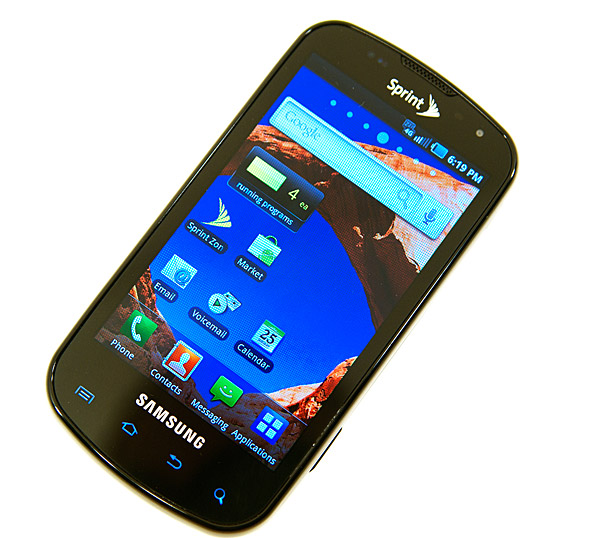
Samsung sent me the Epic 4G, a variant of the Galaxy S for use on Sprint’s network (with WiMAX support as implied by the 4G moniker). The Epic 4G has an amazingly contrasty 4” 800 x 480 Super AMOLED display. The capacitive touchscreen is backed up by a physical keyboard that slides out in landscape mode.
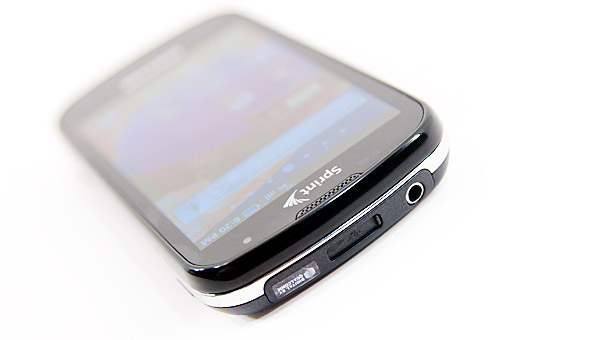
I’d say that Samsung did everything to be the most unlike Apple in the design of the Epic 4G. Along the top you have a microUSB port, but Samsung included a sliding cover to keep the pocket lint out. This adds complexity to the look of the device, but is nicely protective if you’re a bit OCD about getting lint in the crevices of your phone. The sheer location of the microUSB port is unusual as well. Most Android phones we’ve looked at have their power/sync connector at the bottom of the phone, not the top.
The power/lock button also shifts positions compared to what we’re used to. It’s on the right side, near the top on the Epic 4G.
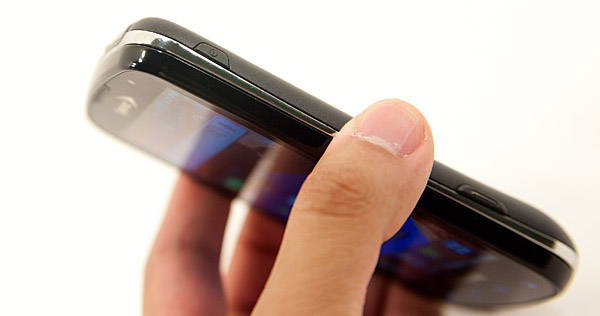
On the lower part of the right side of the phone there’s a shutter release button for the camera. There’s a volume rocker on the left side of the phone. All of the buttons on the Epic 4G have a rubbery texture to them with the exception of the shutter release button which has a metal insert surrounded by rubber.
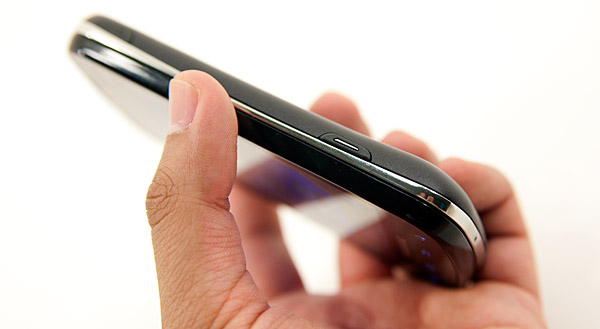
The screen slides up to reveal a landscape keyboard on the Epic 4G. The sliding mechanism is easy enough to operate with one hand and reasonably smooth. It’s not the most confidence inspiring but not terrible either.
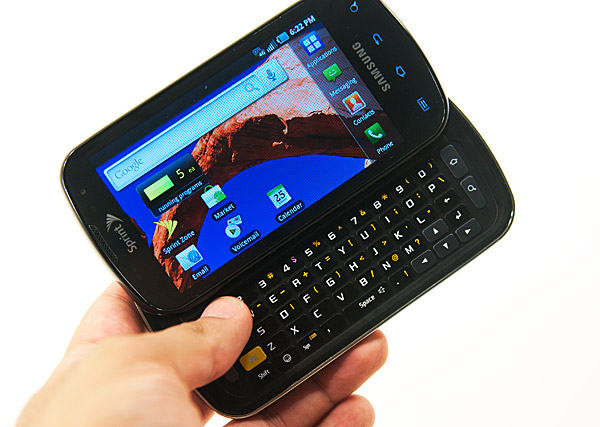
The physical keyboard itself is a nice addition for those who must absolutely have it. Samsung even duplicates the four Android keys on the keyboard itself (home, back, menu, and search) so you can exclusively use the physical keyboard for navigating the OS if you’d like. There is no scroll ball or equivalent on the Epic 4G, but the physical keyboard does have four arrow keys you can use in its stead.
The keys on the physical keyboard are fairly wide and reasonably spaced (it is a landscape keyboard after all). The keys are missing some curved definition that would make it easier to touch type on them but overall it’s not a bad keyboard. Again, not the best I’ve encountered but not terrible at all.
Since this is a slider phone, build quality isn’t the easiest to guarantee. The two halves of the phone independently feel well made, but the joining of the two isn’t super secure. The “oreo effect” as Brian likes to call it is very present on the Epic 4G. You can twist the top and bottom halves of the phone and get them to separate by a couple of degrees. It’s not terrible but if having a loose feeling phone bothers you then you may want to look elsewhere.

The four standard Android keys are also present in capacitive touch form along the bottom edge of the Epic 4G. Unlike most other Android phones, the capacitive buttons aren’t visibly outlined on the phone. You can only see them if they’re backlit, which has a timer associated with it that’s by default separate from the screen timer. What this means is that the row of Android buttons will actually disappear before the screen goes blank if you don’t touch the phone. Thankfully Samsung provides a setting to sync these two so both the screen and buttons go blank at the same time, but it’s just not enabled by default.
The Epic 4G is a good fit in my hand, but with a physical keyboard it is a thicker phone than most I’m used to. If you’re coming from a standard cellphone or feature phone, the Epic 4G is going to feel huge - if you’re coming from another Android/iOS device, it won’t be too bad.

From left to right: Google Nexus One, Samsung Epic 4G, iPhone 4
The phone is a mixture of materials, with the front being glossy plastic, then a chrome strip around the middle and a matte black back cover.
The back cover snaps off with relative ease revealing the 1500mAh battery, a microSD card slot and what looks like four external antenna connectors. I’m not really sure what the exposed connectors are for, perhaps to help during hardware testing/debug. Not having to take the battery out to get to the microSD card is a nice addition as well. The phone comes with a 16GB card as well as a microSD to SD card adapter for use in standard card readers.

Finally on the back we have a lens for the 5MP camera sensor and a single LED flash.
| Physical Comparison | |||||||||
| Apple iPhone 4 | Apple iPhone 3GS | Samsung Epic 4G | HTC EVO 4G | Motorola Droid X | |||||
| Height | 115.2 mm (4.5") | 115 mm (4.5") | 124 mm (4.9") | 121.9 mm (4.8") | 127.5 mm (5.02") | ||||
| Width | 58.6 mm (2.31") | 62.1 mm (2.44") | 63.5 mm (2.5") | 66.0 mm (2.6") | 66.5 mm (2.62") | ||||
| Depth | 9.3 mm ( 0.37") | 12.3 mm (0.48") | 15.2 mm (0.6") | 12.7 mm (0.5") | 9.9 mm (0.39") | ||||
| Weight | 137 g (4.8 oz) | 133 g (4.7 oz) | (5.47 oz) | 170 g (6.0 oz) | 155 g (5.47 oz) | ||||
| CPU | Apple A4 @ ~800MHz | Apple/Samsung A3 @ 600MHz | Samsung Hummingbird @ 1GHz | Qualcomm Scorpion @ 1GHz | TI OMAP 3630 @ 1GHz | ||||
| GPU | PowerVR SGX 535 | PowerVR SGX 535 | PowerVR SGX 540 | Adreno 200 | PowerVR SGX 530 | ||||
| RAM | 512MB LPDDR1 (?) | 256MB LPDDR1 | 512 MB LPDDR1 | 512MB LPDDR1 | 512MB LPDDR1 | ||||
| NAND | 16GB or 32GB integrated | 16 or 32GB integrated | 1 GB integrated, 16 GB microSD preinstalled | 1 GB integrated, 8 GB microSD preinstalled | 8 GB integrated, preinstalled 16 GB microSD | ||||
| Camera | 5MP with LED Flash + Front Facing Camera | 3MP with autofocus | 5 MP with LED Flash and autofocus | 8MP with dual LED Flash + Front Facing Camera | 8MP with dual LED Flash | ||||
| Screen | 3.5" 640 x 960 LED backlit LCD | 3.5" 320 x 480 | 4.0" 480 x 800 | 4.3" 480 x 800 | 4.3" 480 x 854 | ||||
| Battery | Integrated 5.254Whr | Integrated 4.51Whr | Removable 5.55Whr | Removable 5.5Whr | Removable 5.698 Whr | ||||










93 Comments
View All Comments
dk99 - Tuesday, September 7, 2010 - link
Why is it so easy to see the pixels on the epic's screen? It seems annoying.Look at the first picture on the display page on Anand's article.
http://images.anandtech.com/reviews/gadgets/Samsun...
Anand Lal Shimpi - Tuesday, September 7, 2010 - link
The camera/lighting plus running the screen at full brightness exaggerates pixel pitch a bit but remember this device has the same resolution as the Nexus One but with a larger screen.Take care,
Anand
dk99 - Tuesday, September 7, 2010 - link
I had a chance to check out an Epic 4g at the local sprint store and compared it to the Evo screen. The pixels were more easily seen on the Epic and it did bother me, but I guess it may not bother others as much.Here is a picture from another review site demonstrating the pixels:
http://www.mobilecrunch.com/wp-content/uploads/201...
Anand, Thank you for a great website.
Aigoo - Tuesday, September 7, 2010 - link
Pentile RGBGhttp://en.wikipedia.org/wiki/PenTile_matrix_family
:(
pvdw - Tuesday, September 7, 2010 - link
You mention the problem with jerkiness on Android phones, but I find my Desire is wonderfully smooth. It's almost exactly the same hardware as the Incredible, but with better build quality, and I've found no SMS scrolling problems.My Desire is unbranded, so there's no junk from operators like Sprint, etc. installed. Maybe this makes a difference?
And I manage to easily get a days worth of business use out of it - remote access, phone calls, web, etc. 30 hrs on lighter use.
I sure would love to have a better gpu, like the Galaxy S, and, more importantly, a screen that I can see in daylight without squinting.
joncat - Tuesday, September 7, 2010 - link
I wouldn't say that the SGX 540 is a waste of hardware today. While there are nowhere near the amount of 3d games that IOS has, there are several high quality titles that run great on the galaxy s. Need for Speed Shift and the Sims 3 HD by EA, NOVA, Sandstorm, Assasin's Creed, Hero of Sparta, Asphalt5, to name a few by Gameloft all run great at native resolution, which can't be said for phones like the EVO and Incredible that run on the Snapdragon SOC.Mumrik - Tuesday, September 7, 2010 - link
I absolutely love that we're back to using Quake 3 as a GPU performance benchmark.It stuck around for a long ass time in the first place and now it's back :-D
Mumrik - Tuesday, September 7, 2010 - link
Anand, is there a reason you don't test standby battery life?It's a pretty essential number...
Even if it prevents you from getting the review up fast, you could always just post the review and add the data later after averaging out 2-3 tests.
SomeAudioGuy - Tuesday, September 7, 2010 - link
Ok, so I've had an Epic 4G for about three weeks now. Battery life is completely on par for any other smartphone in this segment.I did switch my background to a darker one (the tent with star trails), but other than that I've done very little to mod the device. I don't even use ATK or juicedefender, and I use the built in auto backlight setting to manage brightness. I did not use any 4G today.
I pulled the phone off my charger at 7am, it's 4pm now. I streamed two hours of Pandora, made one 30 minute phone call and three 5 minute phone calls. Took three pictures and uploaded them to twitpic, have been using Tuiteur, facebook, and checking email on 4 different gmail accounts (with background sync enabled). Spent five minutes yelping a spot for lunch. Played about 15 minutes worth of games (GalCon Flight Control, and Simple Dice), helped debug a wireless router (which required about 20 minutes of wi-fi use), and just spent the last 5 minutes looking up geocaches in my area.
My battery is at 35%.
I would term my use as "moderate".
There's absolutely nothing wrong with the battery life on the Epic 4G. Nothing at all for a phone this powerful and with a screen this large.
GPS is a pain, but I find if I turn off GPS throughout the day, and turn it back on before I start an app that requires GPS, i get locks fast enough, and I'm usually down to about 3 meters accurate.
Maybe it's just the signal in Anand's area, but I've gotten better battery life with both EVO and Epic, and even though we TECHNICALLY don't get 4G in LA, when you find pockets of 4G access we're currently getting 4+Mbps down.
Lastly if you're going to review a keyboard slider phone, maybe give the phone to someone who isn't quite so lit on iPhones, and likes to use a hardware keyboard? Just a thought? Exactly TWO sentences are spent on what is quite possibly one of the best keyboards on the market today. No small feat considering this is NOT an HTC phone. No mention of the dedicated number row (who really likes pushing a function key)? No comparison to any other hardware keyboards? Really? Nothing?
Dane74 - Wednesday, September 8, 2010 - link
not ot call BS, on your GPS findings butt eh are out of wahck with all the testing using testing applicaitons. There are several serious problems with Epics GPS. And actually a number of them show up becasue of switching the GPS off. Go to XDA, or androidforums and you will see discussions.'
Your 3 meters accurate is Epic fooling you since it has already been shown the Epic is cooking those numbers..
Look at the pictures published by anantech, or others. Pictures of side by side comparisons showing nubmer of satellites used by the Epic show the serious problem.